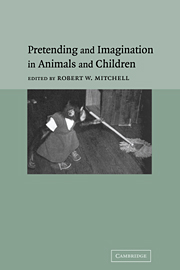Book contents
- Frontmatter
- Contents
- List of contributors
- Foreword by Sue Taylor Parker
- Preface and acknowledgments
- I Historical, developmental, and comparative overviews
- II Pretense and imagination in children
- III Pretense and imagination in primates
- 13 Pretending in monkeys
- 14 Pretending primates: play and simulation in the evolution of primate societies
- 15 Representational capacities for pretense with scale models and photographs in chimpanzees (Pan troglodytes)
- 16 Pretending in free-ranging rehabilitant orangutans
- 17 Seeing with the mind's eye: eye-covering play in orangutans and Japanese macaques
- 18 Possible precursors of pretend play in nonpretend actions of captive gorillas (Gorilla gorilla)
- 19 Pretending culture: social and cognitive features of pretense in apes and humans
- 20 Empathy in a bonobo
- 21 Pretend play in a signing gorilla
- IV Prospects
- References
- Author Index
- Subject Index
21 - Pretend play in a signing gorilla
Published online by Cambridge University Press: 13 August 2009
- Frontmatter
- Contents
- List of contributors
- Foreword by Sue Taylor Parker
- Preface and acknowledgments
- I Historical, developmental, and comparative overviews
- II Pretense and imagination in children
- III Pretense and imagination in primates
- 13 Pretending in monkeys
- 14 Pretending primates: play and simulation in the evolution of primate societies
- 15 Representational capacities for pretense with scale models and photographs in chimpanzees (Pan troglodytes)
- 16 Pretending in free-ranging rehabilitant orangutans
- 17 Seeing with the mind's eye: eye-covering play in orangutans and Japanese macaques
- 18 Possible precursors of pretend play in nonpretend actions of captive gorillas (Gorilla gorilla)
- 19 Pretending culture: social and cognitive features of pretense in apes and humans
- 20 Empathy in a bonobo
- 21 Pretend play in a signing gorilla
- IV Prospects
- References
- Author Index
- Subject Index
Summary
Consider the following examples of pretense:
Michael runs around his room dragging a small plastic wagon behind him, sometimes letting it “catch up,” and then he screams in mock terror.
Chantek talks to his toy animals and offers them food and drink.
Viki walks about the house, “pulling” what seems an imaginary toy on a string. She stops occasionally and tugs at the “string,” as if the “toy” is caught on something. Once, she “dipped” the item into the toilet bowl, raising and lowering the “string.”
Koko lifts an empty toy teacup to her lips and makes loud “slurping” sounds, as if drinking.
Austin pretends to eat imaginary food with gusto, scooping out and swallowing large bites of nothing.
What could be more obvious as examples of pretense? In the first two examples, the pretender playfully attributes animate qualities to a blanket and toys and, in the second three, the pretender treats nothing as a toy, as tea, and as food. If Viki, Chantek, Michael, Koko, and Austen were human toddlers, most observers would not hesitate to call these episodes examples of “pretend play.” But these are not human children, they are great apes: chimpanzees (Hayes, 1951; Savage-Rumbaugh, Shanker & Taylor, 1998); an orangutan (Miles, 1990); and lowland gorillas (Patterson & Kennedy, 1987). In this chapter, we present evidence of pretend play by great apes, focusing on one in particular – the sign-language-using gorilla Koko.
- Type
- Chapter
- Information
- Pretending and Imagination in Animals and Children , pp. 285 - 304Publisher: Cambridge University PressPrint publication year: 2002
- 4
- Cited by



